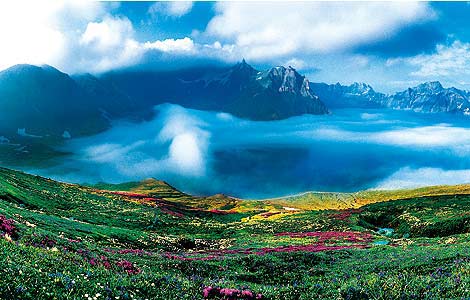
China’s water industry normally defines high-end water as products above 4 yuan per bottle of about 500 milliliters.
But to Liao, only mineral water can be called high-end water.
"At least 70 percent of China’s surface water have been polluted. Unlike surface water, mineral water is usually hundreds of meters underground, so it’s free from contamination," Liao said.
He added that, also unlike surface water, mineral water is considered a mineral reserve of the state and thus is subjected to an extra resources tax, which adds up to the cost of the water.
"People who have been to a decent mineral water production base would realize that the price they are paying is not too high," Liao said. "The Kunlun Mountains water is actually being sold at a low price."
Kunlun is sold at 4.8 yuan for a bottle of 510 ml.
At a Ito Yokado outlet in Beijing, most consumers surveyed by China Daily couldn’t tell the difference between "mineral water" and "mineral substance water", a kind of water that is made of surface water with mineral substances added during processing.
"Isn’t this mineral water?" a consumer asked, pointing to Nongfu Spring, a bestseller in the store, according to Ito Yokado’s managers. Nongfu Spring is made of reservoir water.
Sales staff at a Ito Yokado’s Beijing store said that bottled water with high-price tags is difficult to sell, including Kunlun Mountains water.
"5100 Tibet sometimes sell well, but only when there’s a promotion," a staff member said. When there is a promotion, 500 ml of 5100 Tibet sells for 8.9 yuan, down from 10.9 yuan.
"I often quietly observe people’s buying habits in stores. In most cases, after a long comparison, young men take the cheapest bottled water," Liao said.
In addition to the Chinese consumers’ low loyalty to bottled water brands, there is widespread cynicism about the manufacturers’ claims regarding the place of origin.
"I would pay more money to buy Kunlun Mountains water if it is really from Kunlun Mountains," a women in her twenties said. "But is it really from there?"
Better strategies
But despite the low recognition and trust, some brands were able to steer away from traditional sale channels, such as stores, and found opportunities elsewhere.


 Washington to remain focused on Asia-Pacific
Washington to remain focused on Asia-Pacific RQFII target blue chips amid bear market
RQFII target blue chips amid bear market Australian recall for top two exporters
Australian recall for top two exporters China fears new car restrictions
China fears new car restrictions